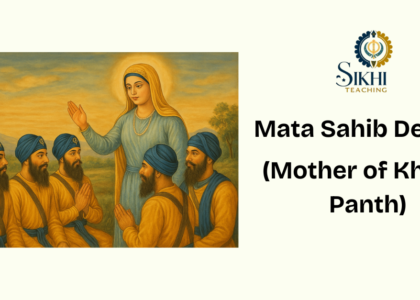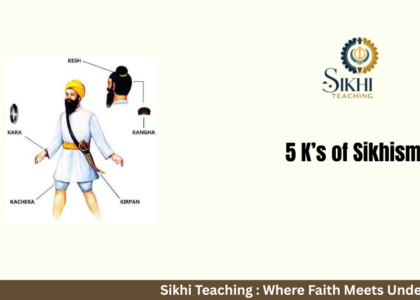What is Sikhism? The religion of Sikhism originated in Punjab, North India, approximately 500 years ago. Sikh means “learner” or “student.” Sikhs hold that there is only one God, who is the same for everyone regardless of background, culture, or religion. The teachings of ten Gurus (spiritual leaders) and their sacred text, the Guru Granth Sahib Ji, serve as the foundation for the faith.
Unlike many religions that grew over thousands of years, Sikhism is one of the youngest world religions and is still followed by around 25–30 million people worldwide.
What is Sikhism : Origins & History of Sikhism
Guru Nanak Dev Ji established Sikhism in the fifteenth century. There were many religious differences and inequalities in India at the time. According to Guru Nanak Sahib Ji, God resides within every human being and all people are created equal.
Each of the nine Gurus who followed Guru Nanak Ji helped to establish Sikh customs, values, and a sense of community. Ultimately, the holy text, the Guru Granth Sahib Ji, was bestowed the Guruship by the tenth Guru, Guru Gobind Singh Ji. Sikhs have regarded the sacred text as their everlasting Guru ever since.
Ten Gurus of Sikhism

The Ten Gurus are like the backbone of Sikhism. Each Guru taught something important:
| Guru | Timeframe | Contribution |
|---|---|---|
| Guru Nanak Sahib Ji | 1469–1539 (Guruship: 1469–1539) | Founded Sikhism; preached oneness of God, equality, and social justice. |
| Guru Angad Sahib Ji | 1504–1552 (Guruship: 1539–1552) | Introduced the Gurmukhi script; promoted physical fitness and discipline. |
| Guru Amar Das Ji | 1479–1574 (Guruship: 1552–1574) | Institutionalized Langar (community kitchen); promoted women’s rights. |
| Guru Ram Das Ji | 1534–1581 (Guruship: 1574–1581) | Founded Amritsar city; composed hymns for Sikh weddings (Lavan). |
| Guru Arjan Sahib Ji | 1563–1606 (Guruship: 1581–1606) | Compiled the Adi Granth; built Harmandir Sahib; first Sikh martyr. |
| Guru Hargobind Ji | 1595–1644 (Guruship: 1606–1644) | Introduced Miri-Piri; created a Sikh military tradition. |
| Guru Har Rai Ji | 1630–1661 (Guruship: 1644–1661) | Spread Sikhism peacefully; emphasized compassion, nature, and healing. |
| Guru Har Krishan Ji | 1656–1664 (Guruship: 1661–1664) | Known as Bal Guru; served smallpox victims in Delhi. |
| Guru Tegh Bahadur Ji | 1621–1675 (Guruship: 1664–1675) | Martyred defending religious freedom for Hindus and others. |
| Guru Gobind Singh Ji | 1666–1708 (Guruship: 1675–1708) | Founded the Khalsa; passed Guruship to Guru Granth Sahib Ji. |
what is sikhism : Core Beliefs in Sikhism
At its heart, Sikhism is simple and sikhism beliefs and principles are as follows:
| Core Principle | Explanation |
|---|---|
| One God (Ik Onkar) | Belief in one universal God, not limited to any place or religion. |
| Equality | All human beings are equal—regardless of wealth, gender, or status. |
| Seva (Selfless Service) | Serving others without expecting anything in return. |
| Honest Living | Earn a livelihood through honest means and hard work. |
| Naam Japna | Meditating on and remembering God’s name through prayer and devotion. |
These values are not only for Sikhs—they can be practiced by anyone to make life meaningful.
One God (Ik Onkar, Waheguru)

Sikhs believe in Waheguru (Wonderful Lord). “There is One God” (Ik Onkar) is the first phrase in Guru Granth Sahib Ji. It implies that God transcends all religions, castes, and colors.
What is sikhism: Philosophy: Maya, Liberation & Unity
Maya = Distracting illusion of the world (money, power, ego).
Mukti (Liberation) = By leading an honest life, one can achieve Mukti (liberation), which is freedom from the cycle of birth and death.
Unity = Unity is the belief that all people are equal children of a single God.
Symbolism of Miri & Piri

Balance is taught in Sikhism:
Miri (worldly life): Protect justice, work hard, and take care of your family.
Piri (spiritual life): Be modest and maintain your relationship with God.
Sikhs are strong physically and spiritually because of this balance.
What is Sikhisim : Sikh Scriptures
Guru Granth Sahib Ji is the primary sacred text. It is a compilation of prayers, poetry, and hymns by saints of various religions as well as Sikh gurus. That demonstrates how Sikhism values diversity.
Guru Arjan Dev Ji assembled the first edition of the Adi Granth.
Dasam Granth: Guru Gobind Singh Ji’s writings.
Sarbloh Granth: Spirituality and fortitude texts.
The Guru Granth Sahib Ji is special because it is sung in Raagas, or melodic patterns, making prayers sound like music!
Key Practices of Sikhism: 5ks of Sikhism

Khalsa Identity, or the Five Ks
The Five Ks are followed by Sikhs who are initiated into the Khalsa:
Kesh: Uncut hair (out of reverence for God’s creation)
Kangha: Wooden comb (tidiness)
Kara: Steel bracelet (connection to God, discipline)
Kachera: Special shorts (control)
Kirpan: Sword (protection of justice and truth)
What is SIkhism In india: Seva, Simran, Kirtan, Langar in Sikhism
Seva: Volunteer work such as cooking, cleaning, and aiding the underprivileged.
Simran: Using prayer to remember God.
Kirtan: Hymns sung.
Langar: A free kitchen where all people, regardless of wealth, gather to eat.
What is SIkhism In india: Sikh Festivals & Ceremonies

Gurpurabs: Gurus’ birthdays (such as Guru Nanak Jayanti).
Vaisakhi: Khalsa was founded in 1699.
A Sikh celebration of bravery and strength is called Hola Mohalla.
Guru Hargobind Ji’s release from prison is commemorated on Diwali (Bandi Chhor Divas).
These festivals are not only religious but also community gatherings with music, food, and celebrations.
What is SIkhism In india :Social Principles in Sikhism: Justice, Equality, Community
Sikhism firmly believes in:
- Absence of a caste system
- The equality of women
- Combating injustice
- Giving to those in need
Sikhs are frequently involved in disaster relief efforts across the globe as a result.
Sikhism Today: Diaspora & Demographics
Globally, there are roughly 30 million Sikhs. There are sizable Sikh communities in Canada, the United Kingdom, the United States, and Australia, but the majority reside in Punjab, India. Sikhs establish Langar kitchens and construct Gurdwaras (temples) wherever they go.
What is SIkhism In india :Sikh Sects & Diverse Traditions
Groups within Sikhism include:
Sikhs who are Khalsa (initiated)
Nanakpanthis, or Guru Nanak’s adherents
The warrior tradition, or Nihangs
Despite having somewhat different practices, these groups all believe in Guru Granth Sahib Ji.
What is SIkhism In india: Differences from Other Religions
Unlike Hinduism → No idol worship.
Unlike Islam/Christianity → No concept of “chosen people.” God is for all.
Unique → Guru Granth Sahib Ji treated as a living Guru.



